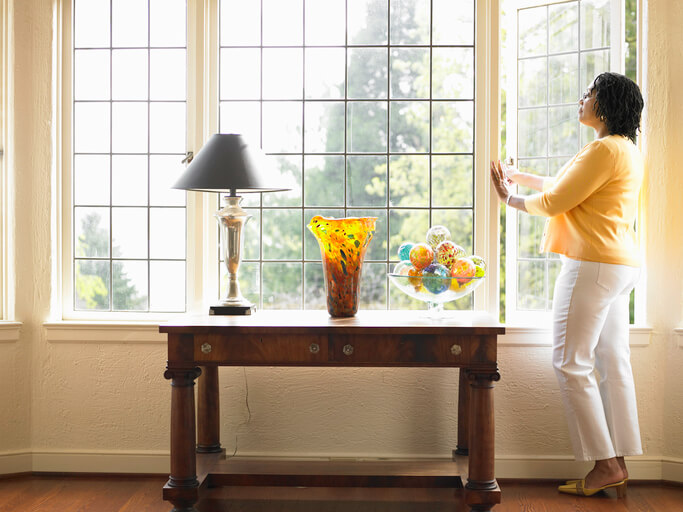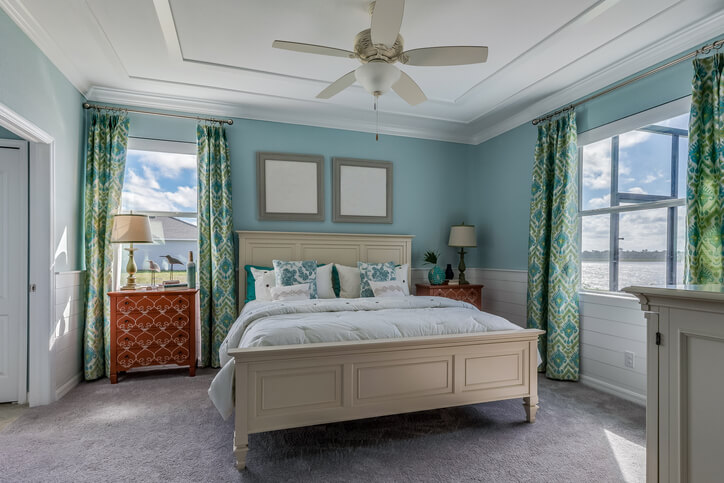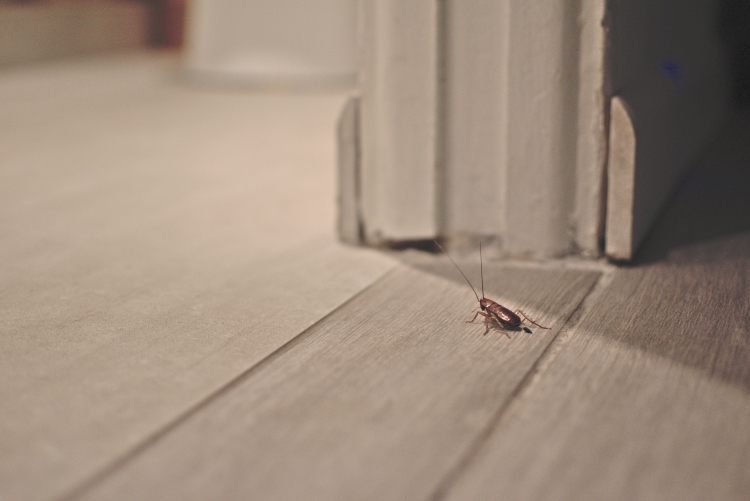In the heat of the summer months, many of us feel tempted to turn our thermostat down just two or three more degrees to achieve a sense of cooling relief. What we may not be aware of, however, is that those two or three little degrees may make quite a difference in your summertime electric bill. According to the U.S. Department of Energy, 6% of the electricity produced in the U.S. is used to run air conditioners and at a cost to homeowners of more than $29 billion a year.
While you may be willing to pay that price to stay cool, you don’t have to. Below are nine ways you can get cooler this summer without breaking the bank.
1. Strategically Open Your Windows
As a rule of thumb, if your air conditioner is on, you’ll want to keep your windows closed. A popular myth advises that opening windows while running your air conditioning will help cool a room faster, because the open windows let the hot air out, allowing the cool air to replace it.
What actually happens, though, is that the cool air generated by your air conditioner escapes through the open windows. Your best option would be to open your windows only when the air temperature outside your home is cooler than the air temperature inside and only while your air conditioner is turned off.

If you are going to open windows to cool your home, being strategic about it can maximize the cooling effect and increase your financial savings. For example:
- Open the downstairs windows on the shaded side of your house and the upstairs windows on the sunny side. Because heat rises, doing so will pull air up through the house, creating a draft to maximize air flow, pulling the cool air throughout the house.
- You can achieve a similar effect if you open the downstairs windows on the side of your house facing into the wind and the upstairs windows on the side facing away from the wind. Doing this changes the air pressure, pulling cool air in through one side of house.
If you do opt to open windows to cool your home, be sure to close them as soon as the temperature outside becomes higher than the temperature inside.
2. Turn up the Temperature When You’re Away
You may have heard that maintaining a constant temperature in your home is an efficient and money-saving tactic when it comes to your cooling system. Many people believe that allowing their homes to warm up will tax their air conditioners, causing the units to work harder to re-cool a space.
This, however, is a myth. Experts actually recommend turning your thermostat up at least a few degrees when you are away from home on a warm day. You can then turn it back down to the desired temperature when you return.
3. Install a Programmable Thermostat
A programmable thermostat can allow you to adjust the temperature of your home without the hassle of having to remember to do so, or having to sit and sweat while you wait for your home to return to a comfortable temperature.
These thermostats allow you to create a schedule for your home cooling. You tell your thermostat when it should turn the temperature up or down at various points during the day. Once you’ve plugged in the settings, you don’t have to worry about remembering to turn the temperature up when you leave or back down again when you return. Instead, the thermostat will have your house at the desired temperature when you arrive.
Plus, you’re likely to save up to 10% on your annual heating and cooling costs if you simply set your thermostat seven to 10 degrees warmer eight hours out of the day. A programmable thermostat can remember to do that for you.
4. Install a Whole-House Fan
Installed in your attic, whole-house fans run at night, when temperatures cool down, replacing the warmer air inside with the cooler air from outside.
Whether or not a whole-house fan would be effective for your home depends on where you live. These fans are best suited for dry climates that feature cooler nighttime temperatures. For instance, if the air outside at night is below 70 degrees, a whole house fan may be a great option for you. On top of this, whole house fans provide three to six air changes per hour, which can keep the air in your home and attic fresh. And overtime, you’ll also save significant amounts of money on cooling.
5. Landscape for Maximum Cool
Taking your particular climate into consideration is important when planning landscape designs to reduce your summer cooling costs. Some landscaping recommendations that apply in most areas include:
- Planting tall trees with wide canopies on the south side of your home can help shade your roof from summer sun during the peak daylight hours, thus reducing solar heat gain.
- On the west side of your home, consider planting shorter trees or tall bushes to shade the walls from the late afternoon sun.
- Evergreen trees to the northeast can help direct warm southerly winds away from your home and create southwesterly winds.
- Planting low-lying shrubbery anywhere around the foundation of your home can keep the ground surrounding your home cool, but be sure to leave enough space between your home and the bushes for air to flow.
While many people view climbing vines such as ivy as damaging, these vines can actually be very beneficial on brick or stone houses. Allowing vines to grow on the south and west walls of your home can help shade them. Provided you keep all air intakes clear, shading your air conditioner by planting bushes around it can increase its efficiency by 10% and can decrease your bills by up to 50%.
Finally, planting ground cover in areas that are currently bare or that feature pavement can decrease the temperature around your house by 10 degrees. Since the energy consumption of your air conditioner directly relates to the temperature difference inside your house versus outside, keeping the air around your house cooler reduces the load on your air conditioner.
6. Cover Your Windows
While any drawn window treatments can help prevent solar heat gain in your home, drapes with blackout lining are designed specifically to prevent it. However, when closed, they will keep your house dark.
If you want to let in the sun’s light without the sun’s heat, you can pair blackout curtains with translucent window coverings or window film. Simply close the blackout curtains for maximum protection from summer heat when you leave home and open them only when you are home.
Even when blackout curtains are open while you are home, the translucent drapes or window film will let in light while still helping decrease solar heat gain. This reduces the burden on your cooling system and saves you money.
7. Use Ceiling Fans
Even though ceiling fans do not cool the air, they do move it. This movement creates a cooling effect that can allow you to set your thermostat higher without feeling warmer, thus cutting down your cooling bill. To reap the maximum money-saving benefits of a ceiling fan, make sure to install it wisely.
First, ceiling fans are most efficient when hung seven to nine feet above the floor and 10 to 12 inches from the ceiling. Second, make sure you choose a fan of an appropriate size for your space. The U.S. Department of Energy recommends fans 36 to 44 inches in diameter for rooms of 225 square feet or smaller. For larger rooms, opt for a 52-inch or larger diameter. If your space is longer than 18 feet, you may want to consider installing multiple fans.
You can save even more energy and money by turning ceiling fans off when you leave the room. As fans cool people, rather than spaces, a running fan is a waste of energy in an empty room where no one is present to enjoy the breeze.

8. Change Your Air Filters
Regularly replacing your system’s dirty air filter with a clean one can reduce its energy use by five to 15%, saving you money. In fact, this simple maintenance task is the most important factor in your system’s energy consumption, according to the U.S. Department of Energy. It’s also recommended that you clean or replace filters every four to eight weeks during the summer months to maintain your system’s efficiency.
9. Be Energy Savvy
We’ve talked a lot about things you can do to help keep your cooling costs down this summer, but there are also a few things you should avoid doing. For example, using your oven can increase the temperature of your home. This can force your air conditioner to work harder to keep the space cool. Instead, you may opt to use your outdoor grill or your microwave.
You’ll also want to avoid leaving lights on in unoccupied rooms. Incandescent bulbs give off 90% of their energy as heat, contributing to heat gain in a room and forcing your air conditioner to work harder.
Finally, don’t leave your air conditioner running at the same temperature while you’re away from home. When you leave, turn the thermostat up or turn the unit off altogether. Better yet, install a programmable thermostat to do it for you. You won’t regret the money savings that result.







My attic has insulation, and this was a money saver from the beginning, as it keeps the house cooler. Southern California doesn’t have an insulation policy and many homes don’t have insulation, and it makes a difference in the cost of cooling and heating the home.
I live in the High Desert of California. To save electricity, I use an evaporative cooler with up-ducts venting into the attic, that vents the hot air out. The evaporative cooler works best in arid environments, it does require annual maintenance in the spring, and it is cheaper to run than an air conditioner. You have to tolerate it a little warmer, because it doesn’t get cold, but it does get cool, and it is nice to have fresh air.
You missed one tip that I think helps keep my summer bill low. It’s installing a solar powered attic exhaust fan. This fan helps remove the 130+ degree air from the attic and replacing it with 95 degree air from outside. Homes today vent the attic space to let convection remove the hot air; the solar attic fan does a better job. Your ceiling insulation now protects against 110 degree hot air, not 130+ degree air.
I didn’t know anything about planting shurbs and tree to keep the house cooler thank you.
A whole house fan isn’t good if you have allergies
THANK YOU, THIS IS MOST HELPFUL … CUTTING UNNESSARY COSTS IS VITAL !!!
I love the Hartford. Here are a few more Summer tips. Warm are rises and ceiling fans actually make you hotter by mixing the warm ceiling air with the much cooler waist-high air. Instead use horizontal waist-high fans.
Upgrade to the newest LED bulbs which can use as little as 5 watts of power.
Tune-up your A/C filter by flipping it over and running your vacuum cleaner over it to suck the dirt out of the filter element. Then you can re-use it a second time reducing your electric bill and saving you the cost of a filter, around 5 bucks.
On very hot days turn your A/C and go somewhere, the beach, the movies, the mall, the library, make a day of it. Come back in the evening when it’s cooler then turn your A/C back on. Reduce room humidity by placed a bucket of “Damp-Rid” in one corner of the room. Wear short sleeve, short leg light-style clothing and sport short hair styles. Short hair styles also save hot water and shampoo.
Thank you this was very informative
Thank you but I do things anyway.
You advise people not to leave lights on in unoccupied rooms, and you talk about how incandescent bulbs give off heat. Why don’t you advise people to use LED bulbs. They use only a fraction of the energy and electricity that incandescent bulbs do making them much cheaper to use, and they don’t give off heat either.
Isn’t the sun shining on the north side of the house in the summer? Shouldn’t trees be on that side?
Heat seeks a cooler place and flows there. If you turn the a/c up the sun is still putting heat in the house. It is not just the air. Heat soaks into the walls and carpet and drapes etc. When you come home and turn the air down it has to remove all that stored up heat to get down to your comfort level.
Unless you are going to be gone on a trip and are willing to be uncomfortable for a while when you get home, turning the a/c up for a few hours just helps the power company deal with the heat.
I also use a couple of dehumidifiers to keep the humidity down! They really help keep my home (and me!) coller!
Definitely recommend a whole house fan! We use ours to cool the house in the mornings and then again at night when the temps drop, which also exhausts the heat from the attic spaces. House stays cool and AC only runs a few hours. Plus our cooling set temp is 78.
Thanknyou for the energy review. I’m doing most of these, but always looking for ways to improve. Only thing I need is that programmable thermostat! Definitely going to look into this more.
Love the ideas! we love the ceiling fans here too (Northern California) Summer can be hot, and our pets laze under ceiling fans which is not expensive, which I run in Summer! I combo AC with, turn off when open 2 doors+kitchn window for abt 2 hours b4 work–+again at 9pm. I turn off ceiling fans, except bedrm, when sleep! Is Electric is @$55-$60 whole month for small 3bdrm 2bath, dual pane windows, apex roof, house (insulated) (1600sf)! but am also in hills area that can get as breezy as it does hot some days! Still like ivy idea, but use Boganvilla!
Thanks for sharing!! Really great, all great ideas and I do some of them now but will add ground cover in front. I love open doors with screens on– when cool outside, both in a.m. b4 work, then again when it cools off after 9 pm. I don’t have trees unfortunately, so will think about boganvilla!!!
I disagree totally about turning a/c off totally when you are gone. Turn it up somewhat but NEVER off. Your a/c has to work so much harder to cool house again. That is what makes sense to me. Can’t stand a hot house when I comeback home.
We recently converted from an evaporative system to a “central air” system. So, thanks for the tips and explanations! I already did some of them as well, but was a bit surprised on a couple of them and will add them to my “keep cool” routine.
Open windows at night when the air is colder, close them first thing in the morning while closing the curtains for the day. Keeps the house fresh too.
Thank you so much for the informational tips. Some of them I do regularly, and some I have not done yet. But thank you for the knowledge. Somehow I feel this gives me the power overheat. LOL cool breezes to you👍🏽
The most important energy savings is investing in an aluminum solar barrier shield that some companies install as a “lay-over” or “staple up” in your attic like a thick heavy duty aluminum foil that is the best heat shield there is. (confirmed by NASA.) This prevents attic heat from penetrating thru your house room ceilings from the attic (or keeps the solar heat from getting into your attic in the first place). As for the whole house fan, in very hot climates, this defeats the purpose of keeping heat out of your house because 1) most take 750 watts or more to run and this cost to your energy bill is higher than what you save, and 2) there is no benefit in pulling in air that is hotter outside than inside as these fans pull in air from your opposite attic vent.
Warm air rises. Ceiling fans stir that warm air down onto you making you hotter. Horizontal fans create less down force turbulence.
There are around 3 or 4 super hot days every summer. Instead of trying to cool your house with the A/C running steady, about $20 worth of watts, turn it off and go somewhere like the library or movies, mall, etc.
Jeff, depends where you live. In Las Vegas, NV almost every day all summer is hot–as in 100 degrees plus.
Good advice for dealing with summer heat. Many of those listed we have had in place for years, but it is helpful to know we are in keeping with expert points made.
More should be said regarding addressing Climate Change and problems caused by emissions from cars and trucks and how we need to move into transport systems that control emissions and produce fewer toxic air conditions.
How high can you set your a/c vis-a-vis humidity build-up in South Florida?
Set two gallon buckets of Damp-Rid at either end of your house.
Thank you very much I’ve never been a big fan of spider plants but I think I’ll try one of those and one of the mother-in-law‘s tongue you never know I might grab a Boston fern to thank you so much for the information knowledge is power.
When I go to car I will add the trim information